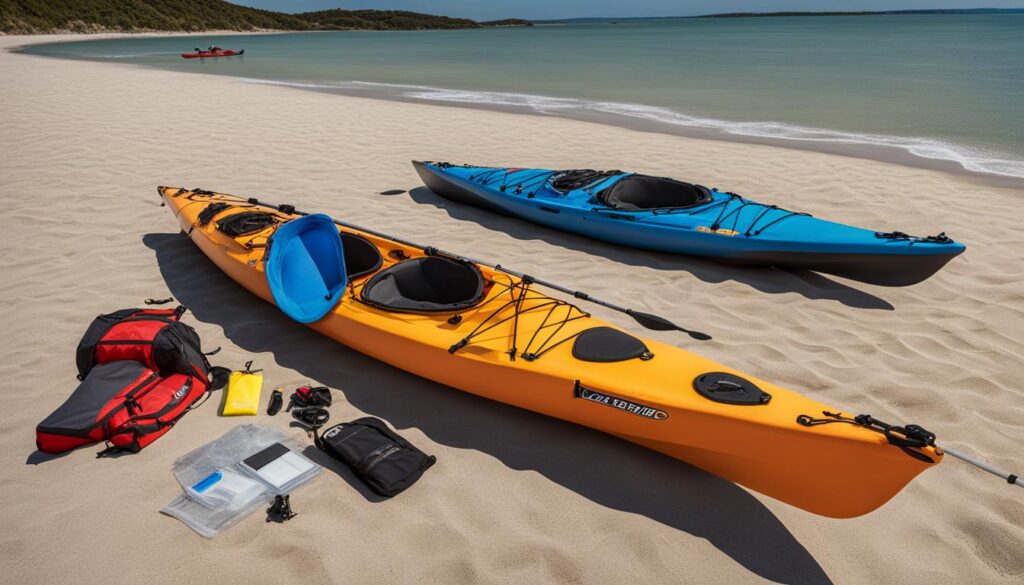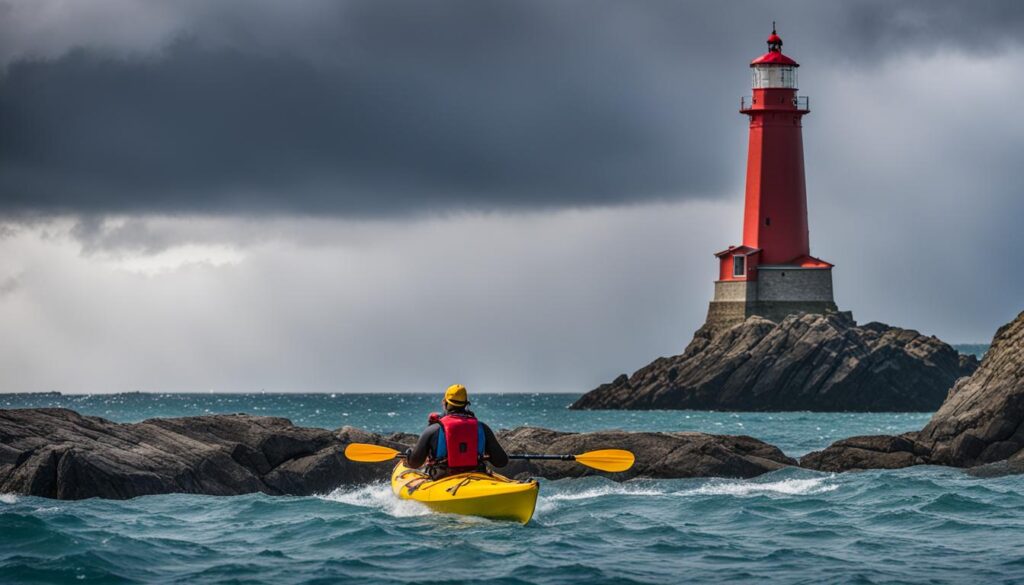Sea kayaking is a thrilling and peaceful way to explore the water. It has a rich history, dating back thousands of years to the Indigenous Arctic people who navigated the seas in kayaks made of hides and whalebone. Today, sea kayaks are designed for stability and efficiency, with features like multiple storage compartments, sealed compartments for floatation, and a rudder or skeg for steering. To get started with sea kayaking, you’ll need the right gear, including a kayak, paddle, and safety equipment. It’s recommended to take a beginner’s course with an instructor to learn basic paddling techniques and safety precautions. Sea kayaking can take you to stunning locations, from the rugged coastlines of Scotland to the icy waters of Greenland. Whether you’re a beginner or an experienced kayaker, there’s always something new to discover in the world of sea kayaking.
Key Takeaways:
- Sea kayaking offers a thrilling way to explore the water.
- Beginners should take a course to learn the fundamentals of sea kayaking.
- Essential gear includes a kayak, paddle, and safety equipment.
- Sea kayaking can take you to stunning locations around the world.
- There’s always something new to discover in the world of sea kayaking.
The Difference Between a Sea Kayak and Other Types of Kayaks
When it comes to choosing a kayak, it’s important to understand the differences between various types. In particular, sea kayaks stand out from the rest with their unique features and design. Let’s take a closer look at what sets a sea kayak apart from other types of kayaks.
Construction and Shape
Sea kayaks are specifically designed for navigating open waters and coastal environments. Unlike recreational kayaks, which are typically shorter and wider, sea kayaks are long, sleek, and narrow. This allows for greater efficiency and speed, making them ideal for longer distances and more challenging conditions.
Additionally, sea kayaks are “sit-in” kayaks, meaning your lower body is enclosed within the hull of the kayak. This design provides better protection from the elements and allows for greater control and stability, especially in rough waters.
| Type | Length | Width | Primary Use |
|---|---|---|---|
| Sea Kayak | 14-18 feet | 21-24 inches | Open water expeditions |
| Recreational Kayak | 8-12 feet | 26-30 inches | Lakes and calm rivers |
| Touring Kayak | 12-16 feet | 23-26 inches | Day trips and multi-day tours |
Features and Performance
Sea kayaks are built with specific features that enhance their performance in the open water. One important feature is the high curved rocker, which refers to the upturned bow and stern of the kayak. This design allows the sea kayak to handle waves and currents more easily, making it more maneuverable in challenging conditions.
Furthermore, sea kayaks often have sealed compartments for storage, which provide both convenience and safety. These compartments not only allow you to carry necessary gear and supplies, but they also add buoyancy to the kayak, making it easier to recover in the event of a capsize.
Essential Gear for Your First Sea Kayaking Expedition
Before embarking on your first sea kayaking expedition, it’s important to have the right gear. Here’s a list of essential kayaking equipment to ensure your safety and enjoyment on the water:
- A kayak: Choose a sea kayak that is stable, maneuverable, and suits your body size and weight.
- A paddle: Opt for a paddle that is lightweight, durable, and the correct length for your height.
- A personal floatation device (PFD): Wear a PFD at all times while kayaking to keep you safe in case of capsizing.
- A wetsuit or drysuit: Depending on the water temperature, dress appropriately to stay warm and comfortable during your expedition.
- A waterproof spray jacket: Protect yourself from wind and water by wearing a waterproof jacket.
- Neoprene boots: Keep your feet warm and protected with neoprene boots designed for kayaking.
- Sunscreen, sunhat, and sunglasses: Shield yourself from the sun’s rays to avoid sunburn and eye strain.
- Drinking water: Stay hydrated throughout your journey by bringing an adequate water supply.
- A helmet: For added safety, wear a helmet to protect your head in case of impact.
- A spray skirt: Prevent water from entering your kayak with a spray skirt that fits snugly around your waist and cockpit.
- Waterproof storage containers and dry bags: Keep your belongings dry and secure by storing them in waterproof containers and bags.
- A first aid kit: Be prepared for any minor injuries by carrying a basic first aid kit with essential supplies.
Remember, having the right gear is essential for a successful and enjoyable sea kayaking experience. Take the time to invest in quality equipment and always prioritize safety on the water. Now that you’re equipped with the necessary gear, you’re ready to embark on your first sea kayaking expedition and embrace the adventure!

Getting Started with Sea Kayaking
If you’re new to sea kayaking, it’s important to start off on the right foot to ensure a safe and enjoyable experience. Here are some tips to help you get started:
- Take a beginner’s course: Before venturing out on your own, it’s highly recommended to take a beginner’s course with a qualified instructor. They will teach you the basic paddling techniques, safety precautions, and how to navigate different water conditions.
- Check the weather conditions: Before launching your sea kayak, always check the weather forecast and wind direction. It’s important to avoid strong winds, heavy rain, or rough seas, especially when you’re just starting out.
- Choose a suitable launch point: When launching your kayak, find a suitable location with shallow water and minimal waves. Face your kayak out to sea and ensure the rudder is up before starting your paddle.
- Paddle with proper technique: Use a relaxed grip on your paddle and practice paddling with straight arms. This will give you more power and efficiency while reducing the risk of strain or injury. Remember to keep your body relaxed and use your core muscles to generate power.
By following these tips and taking the necessary precautions, you can have a safe and fulfilling experience as you embark on your sea kayaking adventure. Remember to always prioritize safety and enjoy the beauty of nature that sea kayaking has to offer.
Testimonials
“I took a beginner’s course before going sea kayaking, and it was the best decision I made. Not only did I learn the essential techniques, but the instructor also taught us about safety measures and how to handle unexpected situations. I felt confident and prepared during my first sea kayaking expedition.” – Sarah
“Launching a sea kayak can be intimidating at first, but with proper guidance and practice, it becomes easier. I learned to choose a suitable launch point, face the waves head-on, and use my paddle to navigate through the surf. It was an exhilarating experience!” – Mark
Safety Considerations in Sea Kayaking
When embarking on a sea kayaking adventure, safety should always be your top priority. Understanding the risks and knowing how to handle emergencies can help ensure a safe and enjoyable experience on the water.
One of the most important safety considerations in sea kayaking is wearing the proper gear. This includes a buoyancy aid and a helmet, which are essential for protecting yourself in the event of a capsize or collision. Wearing a helmet is especially crucial as it helps guard against the risk of hitting rocks or other underwater obstacles.
Another key aspect of sea kayaking safety is paddling within your skill level. It’s important to assess your abilities honestly and avoid pushing yourself beyond your limits. Taking lessons or courses to improve your paddling skills can be beneficial, as it helps build your knowledge and confidence on the water.
In the event of an emergency, it’s essential to have a plan and know how to execute it. Carrying a personal locator beacon (PLB) can be a lifesaver, as it allows you to call for help and provides a precise location to rescuers. Familiarize yourself with the emergency procedures specific to sea kayaking and ensure you have the necessary training and equipment to handle different situations.
Sea Kayaking Safety Checklist:
- Wear a buoyancy aid and a helmet
- Paddle within your skill level
- Take lessons to improve your paddling skills
- Carry a personal locator beacon (PLB)
- Familiarize yourself with emergency procedures
By following these safety considerations and being prepared for potential risks, you can enjoy the beauty of sea kayaking while minimizing the likelihood of accidents or mishaps. Remember, safety should always come first, allowing you to fully immerse yourself in the wonder of exploring the water from the comfort of your sea kayak.

Conclusion
Sea kayaking is not just a recreational activity; it’s a thrilling adventure waiting to be explored. This beginner’s guide to sea kayaking has equipped you with the fundamentals, making it easier for you to dive into this amazing water-based experience. Armed with the right gear, knowledge, and safety precautions, you can embark on your own sea kayaking adventure with confidence.
Whether you choose to paddle in serene bays or challenge yourself in more demanding waters, sea kayaking offers something for everyone. It allows you to connect with nature, explore hidden coastlines, and witness breathtaking sunsets from the water. So, if you’ve been considering trying out sea kayaking, now is the perfect time to start your journey.
Remember, always be respectful of the water and the environment, follow safety guidelines, and continue learning and expanding your skills. With each new sea kayaking adventure, you’ll gain more experience and create lifelong memories. So grab your paddle, find a stunning location, and start your sea kayaking adventure today!
FAQ
What is sea kayaking?
Sea kayaking is a thrilling and peaceful way to explore the water. It involves paddling a long, narrow kayak designed for stability and efficiency in sea and ocean conditions.
What is the history of sea kayaking?
Sea kayaking has a rich history, dating back thousands of years to the Indigenous Arctic people who navigated the seas in kayaks made of hides and whalebone.
What are the distinct features of a sea kayak?
Sea kayaks are long, sleek, and narrow, with a sit-in design. They have sealed compartments for storage, a high curved rocker, and may have a rudder or skeg for steering.
What gear do I need for sea kayaking?
You’ll need a kayak, paddle, warm base layer, wetsuit, waterproof spray jacket, neoprene boots, personal floatation device (PFD), helmet, spray skirt, sunscreen, sunhat, sunglasses, drinking water, waterproof storage containers, and a first aid kit.
How do I get started with sea kayaking?
It’s recommended to take a beginner’s course with an instructor to learn basic paddling techniques and safety precautions. Start with a small group and check weather conditions before launching your kayak.
What are the safety considerations in sea kayaking?
Paddling within your skill level, wearing the correct safety gear, knowing the area, and paddling with a friend are important safety considerations. Carrying a personal locator beacon and wearing a helmet can provide additional safety.





